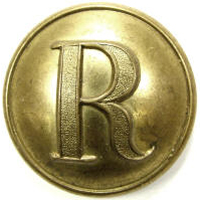
A virtual examination of artifacts of the American Civil War
by Harry Ridgeway
 |
Ridgeway Civil War Research Center, A virtual examination of artifacts of the American Civil War |
| Civil War Weapons, all pre 1898 | |
by Harry Ridgeway |
| Smoothbore percussion musket, Model 1842, Harpers Ferry, 1855, converted to rifled in 1850's, .69cal. . The Model 1842 was manufactured from 1844 through 1855, was the last smoothbore produced as a primary military firearm. It was designed from the beginning as a percussion muzzleloader, .69cal. Rifling and a long range sight was added by the Springfield arsenal in the late 1850's, the musket was not otherwise altered, and was done by simply cutting into the bore. This left relatively weak riffling, otherwise the resultant thinned barrel would be weakened. Manufactured by Harpers Ferry Armory, Harpers Ferry, Virginia (now West Virginia). Marks: Lock is marked HARPERS / FERRY / 1855 behind the hammer, with eagle head and US in front. Barrel is marked VP over eagle head, and an inspector mark, breech tang (date). The barrel date is often different from the date on the lock, as both were made independently, then drawn from stocks as available on assembly or were mixed up in the field. Inspector mark on lock strap. Buttplate is marked US. Model features: Iron buttplate is straight against the shoulder, iron strap opposite the lock, iron trigger guard, originals were not fitted with rear sight, two iron barrel bands, large iron nose guard serves as third band, bayonet lug on bottom of barrel at muzzle, steel ramrod is trumpet head and threaded. Research Center: Weapon1401-Musket-Model-1842-Harpers-Ferry-1855 . Reference: Flayderman 9A-292. Barrel length, 42in. Details click: http://relicman.com/weapons/Weapon1401-Musket-Model-1842-Harpers-Ferry-1855.html |
| W1061 ### Smoothbore percussion musket, Model 1842, Harpers Ferry, 1855, converted to rifled in 1850's, .69cal. . The Model 1842 was manufactured from 1844 through 1855, was the last smoothbore produced as a primary military firearm. It was designed from the beginning as a percussion muzzleloader, .69cal. Rifling and a long range sight was added by the Springfield arsenal in the late 1850's, the musket was not otherwise altered, and was done by simply cutting into the bore. This left relatively weak riffling, otherwise the resultant thinned barrel would be weakened. Manufactured by Harpers Ferry Armory, Harpers Ferry, Virginia (now West Virginia). Marks: Lock is marked HARPERS / FERRY / 1855 behind the hammer, with eagle head and US in front. Barrel is marked VP over eagle head, and an inspector mark, breech tang (date). The barrel date is often different from the date on the lock, as both were made independently, then drawn from stocks as available on assembly or were mixed up in the field. Inspector mark on lock strap. Buttplate is marked US. Model features: Iron buttplate is straight against the shoulder, iron strap opposite the lock, iron trigger guard, originals were not fitted with rear sight, two iron barrel bands, large iron nose guard serves as third band, bayonet lug on bottom of barrel at muzzle, steel ramrod is trumpet head and threaded. Research Center: Weapon1401-Musket-Model-1842-Harpers-Ferry-1855 . Reference: Flayderman 9A-292. Barrel length, 42in. |
| Ridgeway Civil War Research Center, A virtual examination of artifacts of the American Civil War Weapons Research center, weapons, click: http://relicman.com/weapons/Weapon0000-Index.html. Research center, weapons, click: http://relicman.com/weapons/Weapon0000-Index.html. |
| Civil War Relicman,
Harry Ridgeway, Civil War weapons, Relicman sales catalog. Sale listings click: http://relicman.com/weapons/Relicman-Sales-Weapon0000.html. Sale listings click: http://relicman.com/weapons/Relicman-Sales-Weapon0000.html. |